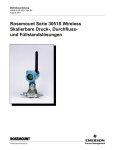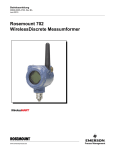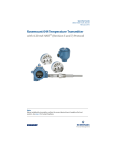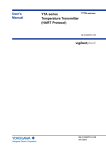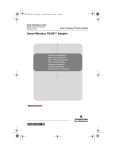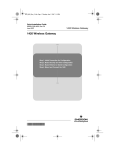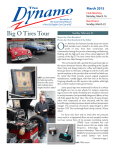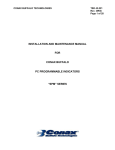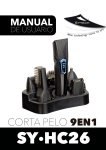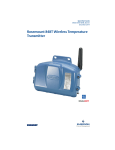Download Emerson 648B Installation guide
Transcript
00825-0100-4648_CC.fm Page 1 Monday, February 13, 2012 12:48 PM Quick Installation Guide 00825-0100-4648, Rev CC February 2012 Rosemount 648 Wireless Rosemount 648 Wireless Temperature Transmitter Start Wireless Considerations Step 1: Physical Installation Step 2: Verify Operation Reference Information Product Certifications Declaration of Conformity End P r oduc tDi s c ont i nue d www.rosemount.com ¢00825-0100-4648[¤ 00825-0100-4648_CC.fm Page 2 Monday, February 13, 2012 12:48 PM Quick Installation Guide 00825-0100-4648, Rev CC February 2012 Rosemount 648 Wireless © 2012 Rosemount Inc. All rights reserved. All marks property of owner. Emerson Process Management Rosemount Temperature GmbH Emerson Process Management Frankenstrasse 21 Rosemount Division Asia Pacific Private Limited 8200 Market Boulevard Chanhassen, MN USA 55317 T (US) (800) 999-9307 T (Intnl) (952) 906-8888 F (952) 906-8889 63791 Karlstein Germany T 49 (6188) 992 0 F 49 (6188) 992 112 1 Pandan Crescent Singapore 128461 T (65) 6777 8211 F (65) 6777 0947 / (65) 6777 0743 [email protected] IMPORTANT NOTICE This installation guide provides basic guidelines for the Rosemount® 648. It does not provide instructions for detailed configuration, diagnostics, maintenance, service, troubleshooting, or installations. Refer to the Rosemount 648 Reference Manual (Document No. 00809-0100-4648) for more instruction. The manual and this QIG are also available electronically on www.rosemount.com. WARNING Explosions could result in death or serious injury: Installation of this transmitter in an explosive environment must be in accordance with the appropriate local, national, and international standards, codes, and practices. Please review the Product Certifications section for any restrictions associated with a safe installation. • Before connecting a Rosemount Field Communicator in an explosive atmosphere, ensure the instruments are installed in accordance with intrinsically safe or non-incendive field wiring practices. Electrical shock can result in death or serious injury. • Avoid contact with the leads and terminals. High voltage that may be present on leads can cause electrical shock. This device complies with Part 15 of the FCC Rules. Operation is subject to the following conditions. This device may not cause harmful interference. This device must accept any interference received, including interference that may cause undesired operation. This device must be installed to ensure a minimum antenna separation distance of 20 cm from all persons. • The Power Module may be replaced in a hazardous area. The Power Module has surface resistivity greater than one gigaohm and must be properly installed in the wireless device enclosure. Care must be taken during transportation to and from the point of installation to prevent electrostatic charge build-up. IMPORTANT NOTICE Shipping considerations for wireless products: The unit was shipped to you without the Power Module installed. Please remove the Power Module prior to shipping the unit. Each Power Module contains two “C” size primary lithium batteries. Primary lithium batteries are regulated in transportation by the U.S. Department of Transportation, and are also covered by IATA (International Air Transport Association), ICAO (International Civil Aviation Organization), and ARD (European Ground Transportation of Dangerous Goods). It is the responsibility of the shipper to ensure compliance with these or any other local requirements. Please consult current regulations and requirements before shipping. 2 00825-0100-4648_CC.fm Page 3 Monday, February 13, 2012 12:48 PM Quick Installation Guide 00825-0100-4648, Rev CC February 2012 Rosemount 648 Wireless WIRELESS CONSIDERATIONS Power Up Sequence The Rosemount 648 and all other wireless devices should be installed only after the Smart Wireless Gateway (“Gateway”) has been installed and is functioning properly. Wireless devices should also be powered up in order of proximity from the Gateway, beginning with the closest. This will result in a simpler and faster network installation. Enable Active Advertising on the Gateway to ensure that new devices join the network faster. For more information see the Smart Wireless Gateway Manual (Doc. No. 00809-0200-4420). Antenna Position The antenna should be positioned vertically, either straight up or straight down, and it should be approximately 3 ft. (1 m) from any large structure, building, or conductive surface to allow for clear communication to other devices. Figure 1. Conduit Entry Upon installation, ensure that each conduit entry is either sealed with a conduit plug using approved thread sealant, or has an installed conduit fitting or cable gland with appropriate threaded sealant. Figure 2. Conduit Entry Conduit Entry 3 00825-0100-4648_CC.fm Page 4 Monday, February 13, 2012 12:48 PM Quick Installation Guide Rosemount 648 Wireless 00825-0100-4648, Rev CC February 2012 Field Communicator Connections The Power Module needs to be installed in the device for the Field Communicator to interface with the 648. Field communication with this device requires a Field communicator using the correct 648 wireless DD. The correct DD for the available protocol should be selected. Refer to Figure 3 below for instructions for connection of the Field Communicator to the 648. Figure 3. Connection Diagram 1 2 P/N 00753-9200-0020 3 4 COMM STEP 1: PHYSICAL INSTALLATION The Rosemount 648 can be installed in one of two configurations: Direct Mount, where the thermocouple or sensor is connected directly to the 648 housing’s conduit entry, or Remote Mount, where the thermocouple or sensor is mounted separate from the 648 housing, then connected to the 648 using conduit. Choose the installation sequence that corresponds to the mounting configuration. Direct Mount The direct mount installation should not be used when installing with a Swagelok® fitting. 1. Install the sensor according to standard installation practices. Be sure to use an approved thread sealant on all connections. 2. Attach the 648 housing to the sensor using the threaded conduit entry. 3. Attach the sensor wiring to the terminals as indicated on the wiring diagram. 4. Connect the Power Module. NOTE: Wireless devices should be powered up in order of proximity from the Smart Wireless Gateway, beginning with the closest device to the Gateway. This will result in a simpler and faster network installation. 4 00825-0100-4648_CC.fm Page 5 Monday, February 13, 2012 12:48 PM Quick Installation Guide 00825-0100-4648, Rev CC February 2012 Rosemount 648 Wireless STEP 1 CONTINUED... 5. Close the housing cover and tighten to safety specification. Always ensure a proper seal by installing the electronics housing covers so that metal touches metal, but do not over tighten. 6. Position the antenna such that it is vertical, either straight up or straight down. The antenna should be approximately three ft. (0,91 m) from any large structures or buildings, to allow clear communication to other devices. Possible antenna rotation shown. Antenna rotation allows for best installation practices in any configuration. Possible antenna rotation shown. Antenna rotation allows best practices for any configuration. Remote Mount 1. Install the sensor according to standard installation practices. Be sure to use an approved thread sealant on all connections. 2. Run wiring (and conduit, if necessary) from the sensor to the 648. 3. Pull the wiring through the threaded conduit entry of the 648. 4. Attach the sensor wiring to the terminals as indicated on the wiring diagram. 5. Connect the Power Module. NOTE: Wireless devices should be powered up in order of proximity from the Wireless Gateway, beginning with the closest device to the Gateway. This will result in a simpler and faster network installation. 5 00825-0100-4648_CC.fm Page 6 Monday, February 13, 2012 12:48 PM Quick Installation Guide Rosemount 648 Wireless 00825-0100-4648, Rev CC February 2012 STEP 1 CONTINUED... 6. Close the housing cover and tighten to safety specification. Always ensure a proper seal by installing the electronics housing covers so that metal touches metal, but do not over tighten. 7. Position the antenna such that it is vertical, either straight up or straight down.The antenna should be approximately three feet (0,91 m) from any large structures or buildings to allow clear communication to other devices. STEP 2: VERIFY OPERATION Operation can be verified in four locations: at the device via the LCD, by using the Field Communicator, at the Gateway via the Smart Wireless Gateway’s integrated web server, or via AMS™ Suite: Intelligent Device Manager. Local Display During normal operation, the LCD should display the PV value at the update rate up to 1 minute intervals. Refer to the Rosemount 648 Manual for error codes and other LCD messages. Press the Diagnostic button to display the TAG, Device ID, Network ID, Network Join Status and Device Status screens. 6 00825-0100-4648_CC.fm Page 7 Monday, February 13, 2012 12:48 PM Quick Installation Guide 00825-0100-4648, Rev CC February 2012 Searching for Network Rosemount 648 Wireless Joining Network Connected with 1 Parent Connected with 2 Parents netwk netwk netwk netwk A -srch JOING 1PARNT 2PARNT Field Communicator To verify operation using a Field Communicator, refer to the Fast Key Sequence in Table 1. Select the Radio State parameter to verify operation. For connecting to a Field Communicator, refer to Figure 3: Connection Diagram on page 4. Table 1. 648 Fast Key Sequence Function Key Sequence Menu Items Network 1, 3, 3 Smart Power, Network ID, Set Join Key, Radio State Smart Wireless Gateway In the integrated web interface from the Gateway, navigate to the Explorer>Status page. This page shows whether the device has joined the network and if it is communicating properly. NOTE: It may take several minutes for the device to join the network. NOTE: If the device joins the network and immediately has an alarm present, it is likely due to sensor configuration. Check the sensor wiring (see Rosemount 648 Terminal Diagram on page 9) and the sensor configuration (see 648 Fast Key Sequence on page 9). Figure 4. Smart Wireless Gateway Network Settings 7 00825-0100-4648_CC.fm Page 8 Monday, February 13, 2012 12:48 PM Quick Installation Guide 00825-0100-4648, Rev CC February 2012 Rosemount 648 Wireless AMS™ Suite: Intelligent Device Manager When the device has joined the network, it will appear in the Device Manager as illustrated below. Troubleshooting If the device is not joined to the network after power up, verify the correct configuration of the Network ID and Join Key, and verify that Active Advertising has been enabled on the Smart Wireless Gateway. The Network ID and Join Key in the device must match the Network ID and Join Key of the Gateway. The Network ID and Join Key may be obtained from the Smart Wireless Gateway on the Setup>Network>Settings page on the web server (see Figure 4: Smart Wireless Gateway Network Settings on page 7). The Network ID and Join Key may be changed in the wireless device by using the following Fast Key sequence. Function Key Sequence Network 1, 3, 3 Menu Items Smart Power, Network ID, Set Join Key, Radio State If the Field Communicator fails to communicate with the 648, open the LCD cover and verify that the communication switch, located next to the LCD, is in the ON position. After this step, verify that the 648 is communicating with the handheld device. 8 00825-0100-4648_CC.fm Page 9 Monday, February 13, 2012 12:48 PM Quick Installation Guide 00825-0100-4648, Rev CC February 2012 Rosemount 648 Wireless REFERENCE INFORMATION Figure 5. Rosemount 648 Terminal Diagram NOTE: In order to communicate with a Field Communicator, the device must be powered by connecting the Power Module. Table 2. 648 Fast Key Sequence Function Key Sequence Device Information 1, 3, 5, 2 PV Range Values 1, 3, 4, 1 Sensor Trim 1, 2, 2, 1 Wireless Sensor Configuration 1, 3, 3 1, 3, 2, 1 Menu Items Tag, Date, Descriptor, Message, Model, Model Number I, Model Number II, Model Number III, Write Protect, Revision Numbers, Transmitter Serial Numbers, Device ID, Distributor Lower Range Point, Upper Range Point, Unit, Apply Values, Lower Sensor Limit, Upper Sensor Limit, Minimum Span Lower Sensor Trim, Upper Sensor Trim, Recall Factory Trim, Active Calibrator Smart Power, Network ID, Set Join Key, Radio State Sensor Configuration, Temp Sensor Setup, Cal VanDusen, Sensor S/N 9 00825-0100-4648_CC.fm Page 10 Monday, February 13, 2012 12:48 PM Quick Installation Guide 00825-0100-4648, Rev CC February 2012 Rosemount 648 Wireless Figure 6. Series 65, Series 68, Series 78, and 58C Lead Wire Configurations Single Element White (1) White (2) Red (3) Red (4) Figure 7. Series 183 Thermocouple Lead Wire Configurations Type J Type E + White (2) + Purple (2) – Red (3) Type K – Red (3) Type T + Yellow (2) + Blue (2) – Red (3) – Red (3) Figure 8. Series 185 Thermocouple Lead Wire Configurations Type J Type N + Black (2) + Red (2) – White (3) – White (3) Type K + Green (2) – White (3) NOTE: The wiring diagrams shown above apply only to Rosemount sensors. 10 00825-0100-4648_CC.fm Page 11 Monday, February 13, 2012 12:48 PM Quick Installation Guide 00825-0100-4648, Rev CC February 2012 Rosemount 648 Wireless PRODUCT CERTIFICATIONS Approved Manufacturing Locations Rosemount Inc. – Chanhassen, Minnesota, USA Emerson Process Management GmbH & Co. - Karlstein, Germany Emerson Process Management Asia Pacific Private Limited - Singapore European Union Directive Information The most recent revision of the European Union Declaration of Conformity can be found at www.emersonprocess.com ATEX Directive (94/9/EC) Emerson Process Management complies with the ATEX Directive. Electro Magnetic Compatibility (EMC) (2004/108/EC) Emerson Process Management complies with the EMC Directive. Radio and Telecommunications Terminal Equipment Directive (R&TTE)(1999/5/EC) Emerson Process Management complies with the R&TTE Directive. Telecommunication Compliance All wireless devices require certification to ensure that they adhere to regulations regarding the use of the RF spectrum. Nearly every country requires this type of product certification. Emerson is working with governmental agencies around the world to supply fully compliant products and remove the risk of violating country directives or laws governing wireless device usage. FCC and IC This device complies with Part 15 of the FCC Rules. Operation is subject to the following conditions: This device may not cause harmful interference. This device must accept any interference received, including interference that may cause undesired operation. This device must be installed to ensure a minimum antenna separation distance of 20 cm from all persons. Ordinary Location Certification for FM As standard, the transmitter has been examined and tested to determine that the design meets basic electrical, mechanical, and fire protection requirements by FM, a nationally recognized testing laboratory (NRTL) as accredited by the Federal Occupational Safety and Health Administration (OSHA). 11 00825-0100-4648_CC.fm Page 12 Monday, February 13, 2012 12:48 PM Quick Installation Guide Rosemount 648 Wireless 00825-0100-4648, Rev CC February 2012 Hazardous Locations Certificates North American Certifications Factory Mutual (FM) Approvals I5 FM Intrinsically Safe, Non-incendive Intrinsically Safe for Class I/II/III, Division 1, Groups A, B, C, D, E, F, and G. Zone Marking: Class I, Zone 0, AEx ia llC Temperature Codes T4 (Tamb = -50 to 70 °C) T5 (Tamb = -50 to 40 °C) Non-incendive for Class I, Division 2, Groups A, B, C, and D. Dust Ignition-proof for Class II/III, Division 1, Groups E, F, and G. Ambient temperature limits: -50 to 85 °C Intrinsically Safe and Non-incendive when installed in accordance with Rosemount drawing 00648-1000. For use with Rosemount Power Module P/N 753-9220-0001 only. Enclosure Type 4X/IP66/IP67 N5 FM Non-incendive and Dust Ignition-proof Non-incendive for Class I, Division 2, Groups A, B, C, and D. Dust Ignition-proof for Class II/III, Division 1, Groups E, F, and G. Ambient temperature limits: -50 to 85 °C For use with Rosemount Power Module P/N 753-9220-0001 only. Enclosure Type 4X/IP66/IP67 Canadian Standards Association (CSA) I6 CSA Intrinsically Safe Intrinsically Safe for Class I, Division 1, Groups A, B, C, and D. Temp Code T3C Enclosure Type 4X/IP66/IP67 For use with Rosemount Power Module P/N 753-9220-0001 only. Intrinsically Safe when installed per Rosemount drawing 00648-1020. 12 00825-0100-4648_CC.fm Page 13 Monday, February 13, 2012 12:48 PM Quick Installation Guide 00825-0100-4648, Rev CC February 2012 Rosemount 648 Wireless European Certifications I1 ATEX Intrinsic Safety Certificate No.: Baseefa07ATEX0011X Ex ia IIC T5 (Ta = -60 °C to 40 °C) Ex ia IIC T4 (Ta = -60 °C to 70 °C) IP66/IP67 II 1G Special Conditions for Safe Use (X) 1. The antenna may present a potential electrostatic ignition hazard and must not be rubbed or cleaned with a dry cloth. 2. The enclosure is made of an aluminum alloy and given a protective polyurethane paint finish; however, care should be taken to protect it from impact or abrasion if located in a zone 0 environment. For use with Rosemount Power Module P/N 753-9220-0001 only. Intrinsically Safe when installed per Rosemount drawing 00648-1020. 1180 Table 3. Sensor Parameters Sensor Uo = 6.6 V Io = 26 mA Po = 42.6 mW Co = 10.9 uF Lo = 500 mH International Certifications I7 IECEx Intrinsic Safety Certificate No.: IECEx BAS 07.0007X Ex ia IIC T6 (Tamb = -60 °C to 50 °C) Ex ia IIC T5 (Tamb = -60 °C to 75 °C) IP66/IP67 Special Conditions for Safe Use (X) 1. The antenna may present a potential electrostatic ignition hazard and must not be rubbed or cleaned with a dry cloth. 2. The enclosure is made of an aluminum alloy and given a protective polyurethane paint finish; however, care should be taken to protect it from impact or abrasion if located in a zone 0 environment. For use with Rosemount Power Module P/N 753-9220-0001 only. Intrinsically Safe when installed per Rosemount drawing 00648-1020. 1180 13 00825-0100-4648_CC.fm Page 14 Monday, February 13, 2012 12:48 PM Quick Installation Guide Rosemount 648 Wireless 00825-0100-4648, Rev CC February 2012 Table 4. Sensor Parameters Sensor Uo = 6.6 V Io = 26 mA Po = 42.6 mW Co = 10.9 uF Lo = 500 mH Japanese Certifications I4 TIIS Intrinsic Safety Ex ia IIC T4 Certificate TC18194. Various configurations available. Consult factory for certified assemblies. China (NEPSI) Certifications I3 China Intrinsic Safety Certificate No.: GYJ071412 Ex ia IIC T4/T5 Table 5. Sensor Parameters Sensor Uo = 6.6 V Io = 26 mA Po = 42.6 mW Co = 11 uF Lo = 25 uH Special Conditions for Safe Use: 1. The cable entry of wireless temperature transmitter should be protected to ensure the degree of protection of the enclosure IP 20 (GB4208-1993) at least. 2. Associated apparatus should be installed in a safe location and, during installation, operation, and maintenance, the regulations of the instruction manual have to be strictly observed. 3. End users are not permitted to change any components insides. 4. During installation, use, and maintenance of the wireless temperature transmitter, observe the following standards: a. GB3836.13-1997 “Electrical apparatus for explosive gas atmospheres Part 13: Repair and overhaul for apparatus used in explosive gas atmospheres” b. GB3836.15-2000 “Electrical apparatus for explosive gas atmospheres Part 15: Electrical installations in hazardous area (other than mines)” c. GB3836.16-2006 “Electrical apparatus for explosive gas atmospheres Part 16: Inspection and maintenance of electrical installation (other than mines)” d. GB50257-1996 “Code for construction and acceptance of electric device for explosion atmospheres and fire hazard electrical equipment installation engineering” 14 00825-0100-4648_CC.fm Page 15 Monday, February 13, 2012 12:48 PM Quick Installation Guide 00825-0100-4648, Rev CC February 2012 Radio Power Label - see Figure 9 - indicates output power configuration of the radio. Devices with this label are configured for output power less than 10 mW e.i.r.p. At time of purchase, the customer must specify ultimate country of installation and operation. Rosemount 648 Wireless Figure 9. Radio Power Label 15 00825-0100-4648_CC.fm Page 16 Monday, February 13, 2012 12:48 PM Quick Installation Guide Rosemount 648 Wireless Figure 10. Rosemount 648 Wireless Declaration of Conformity 16 00825-0100-4648, Rev CC February 2012 00825-0100-4648_CC.fm Page 17 Monday, February 13, 2012 12:48 PM Quick Installation Guide 00825-0100-4648, Rev CC February 2012 Rosemount 648 Wireless 17 00825-0100-4648_CC.fm Page 18 Monday, February 13, 2012 12:48 PM Quick Installation Guide Rosemount 648 Wireless 18 00825-0100-4648, Rev CC February 2012



















